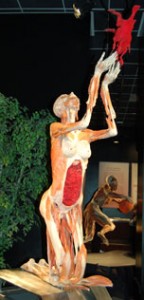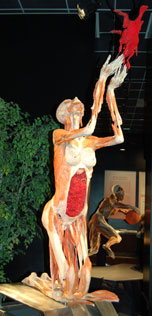By Keisha McDuffie/ne news editor

Body Worlds is as bizarre as it is interesting … almost as if The Night of the Living Dead meets Buffalo Bill.
One of the most controversial exhibits to visit the metroplex, Body Worlds is now on display at the Dallas Museum of Nature and Science through May 28.
The exhibit is a collection of skinned humans, and all of their innards are strewn throughout the five-room anatomical display … well, in so many words.
Each display is a human person with its muscles, blood vessels, organs and everything that is below the skin’s surface exposed for viewing.
A trip through the macabre maze can be awesome or disturbing.
Each of the bodies, or plastinates (how the man behind the Body Worlds empire describes his scientific pieces of art), is arranged in an interesting and difficult stance.
To view the inside of a basketball player’s body while he is dribbling a ball may cause some to gawk.
The basketball player is the most muscular donor palatinates has received thus far. A complex muscle dissection was performed, and the organs were removed to show a large back muscle.
However, a few displays make the basketball player look like a wax museum resident.
For instance, one display, “the longitudinally expanded view,” shows a man\plastinate bent at the knee, but from his torso up, it is as if someone ran opposite directions with his head and feet.
In this piece, the body shell has been cut through at the head, chest and abdominal levels and shifted upward.
The results allow the viewer to see the skull detached from the cerebrum; the heart and lungs are visible through a deeper chest region with the abdominal organs below.
The once-living human presentation leaves most in a state of amazement, wanting to get a closer look, eagerly studying every section of the specimen through the cloudy encasing.
Throughout the exhibit are small doses of shock treatment or fillers of every human organ from A-Z encased in plexiglas displays with descriptions politely laid beside each, i.e. a smoker’s lungs.
In another display, a skinless man sits on his horse, holding both his and the horse’s brain in his hands.
The seemingly larger-than-life roaring horse and rider is easily the most awe-inspiring display.
The horse weighed 1,763 pounds, stood over six-feet tall and required a crane to assemble.
“He shows the greatness and the perfidy of man, as he not only brags about his large brain in comparison to the horse’s puny one, but also lashes the horse that serves him,” Gunther von Hagens, inventor of revolutionary process of plastination, said of this display.
Body Worlds includes more than 200 plastinates and specimens.
The exhibit has been designed for students, teachers, families and adults with the purpose of educating and is capable of teaching more than anatomy.
The exhibit opens questions of ethics and presents strong material for young children.
Still interested?
Admission is $21.50 for adults, $19.50 for students (with ID) and seniors (62 and older) and $13 for children (3-18).
Group rates are available, and museum members are subject to discount ticket rates.
For more information or to order tickets, visit natureandscience.org or call 877-615-489.

